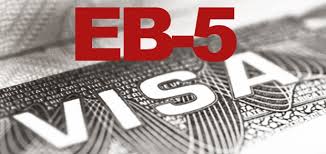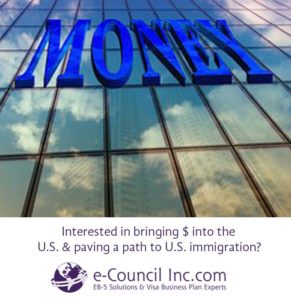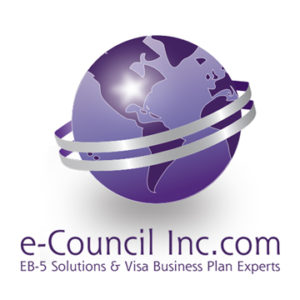
13 Jan Clearing up the Confusion over EB-5 Minimum Investment Amounts
One of the first questions that potential EB-5 applicants ask is: “How much do I need to invest in order to qualify for an EB-5 visa?” While the answer to this question is quite simple, it is often shrouded in confusion. In this article, we will review the single determinant of the minimum investment amount and discuss why the subject is so frequently misunderstood.
Remember Three Words: Location, Location, Location
The single determinant of the minimum investment amount necessary to apply for an EB-5 visa is LOCATION. Specifically, whether the EB-5 project is located in a TEA (Targeted Employment Area) or outside of a TEA.
Currently, a TEA is defined as a “high unemployment area” in an urban setting (i.e. part of a Metropolitan Statistical Area, or MSA) that has an unemployment rate of at least 150 percent of the national average, or a “rural area.”[1] If the project is located in a TEA, the minimum investment amount is $500,000. If the project is not located in a TEA, the minimum investment amount is $1,000,000.
Keep in mind that anticipated reforms to the EB-5 program are likely to raise these minimum investment thresholds. Many experts predict that the new investment amounts will be $800,000 for TEAs and $1,200,000 for non-TEA projects. Reforms may also change how TEAs are defined. [2] Whatever happens, the investment thresholds for TEA projects will likely remain lower than those not located in TEAs. This is because Congress created the TEA incentive to steer capital to high-unemployment areas.[3]
Until changes are enacted (if any), the minimum investment amounts will remain $500,000 for projects located in TEAs, and $1,000,000 for projects located elsewhere.
Do Regional Centers Impact Minimum Investment Amounts?
A common misunderstanding it that the investment amount is determined by the decision to invest via a Regional Center vs. as a direct investment. However, this is not the case. Again, the only determinant of the minimum required investment is whether or not the EB-5 project is located in a TEA.
The reason for the confusion is that many Regional Center projects are located within TEAs, thereby requiring a $500,000 investment (per applicant) (as of the date of posting). However, the fact that the investment occurs through a Regional Center is NOT the determinant of the minimum investment amount. Rather, it is the location of the project. Indeed, a Regional Center project located in a non-TEA would still necessitate a $1,000,000 minimum investment amount.
Similarly, a direct-investment project can be located in a TEA and thereby require a minimum investment of $500,000. If a direct-investment project is not located in a TEA, the required minimum investment amount is $1,000,000.
In sum, the answer to the question, “Do Regional Centers impact minimum investment thresholds?” is: No.
The Real Benefits of Investing in a Regional Center Project
While the decision to invest via a Regional Center does not, in and of itself, impact the minimum investment amount, there are a number of advantages to choosing a Regional Center project over a Direct Investment opportunity.
The main difference between a Regional Center project and a Direct Investment project is the job creation requirement and the management role of the investor.
Regarding job creation, USCIS permits a Regional Center project to count both direct and indirect jobs, while the Direct Investment alternative requires that each individual’s investment in the NCE result in the creation of at least 10 direct W-2 jobs (or preserved jobs in the case of a troubled business).[4] Many see this as an advantage of the Regional Center option.
Concerning the management role of the investor, Direct Investment Projects require the investor – at a minimum – to fill an advisory or policy-making role within the business. This can be accomplished either through the issuance of common shares or preferred equity. In Regional Center projects, investors tend to play a more passive role, usually as a limited partner and or an investing member in a limited liability company. As a result, investors not interested in the day-to-day obligations of running a business may prefer the Regional Center route.
Want to get started with EB-5?
Investors must carefully consider the type of EB-5 investment most appropriate for their individual needs and diligently investigate the suitability of the project for EB-5 investment. e-Council Inc.’s experienced and skilled professionals can assess an investor’s goals and profile to help them select a business that is right for them, and right for EB-5.
e-Council’s attorneys, researchers, and other professionals also specialize in providing due diligence services to equip potential investors with the information needed to assess either the project(s) into which they are considering an investment or the viability and feasibility of opening a new business or investing in an existing business directly and the likelihood that it will pass USCIS scrutiny. If the business passes muster, e-Council Inc. can create a Matter of Ho-compliant business plan and provide the full range of complementary services designed to support the EB-5 application. Working with e-Council Inc. to complete all of your EB-5 documents minimizes the need for outside services from unrelated sources; all of our diverse service providers have been fully vetted and are immediately available.
To inquire about our wide range of EB-5 concierge services, please contact us at info@ecouncilinc.com or toll-free at 1-866-724-0085.
e-Council Inc.’s website, newsletter and other forms of communication contain general information about legal matters. The information is not legal advice and should not be treated as such. You must not rely on the information on this website as an alternative to legal advice from an attorney or other professional legal services provider. For specific questions about any legal matter please consult with an attorney or other professional services provider.
[1]https://www.uscis.gov/working-united-states/permanent-workers/employment-based-immigration-fifth-preference-eb-5/about-eb-5-visa
[2] https://ecouncilinc.com/act-now-take-advantage-latest-short-term-extension-eb-5-program/
[3]http://www.seattletimes.com/business/real-estate/money-from-investor-visas-floods-us-doesnt-reach-poor-areas-meant-to-benefit/
[4] A “troubled business” is one that has been in existence for at least two years, has incurred a net loss for accounting purposes during the twelve- or twenty-four month period prior to the priority date on the alien entrepreneur’s Form I-526, and the loss for such period is at least equal to twenty percent of the troubled business’s net worth prior to such loss. For purposes of determining whether or not the troubled business has been in existence for two years, successors in interest to the troubled business will be deemed to have been in existence for the same period of time as the business they succeeded. 8 C.F.R. § 204.6(e).

